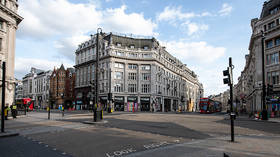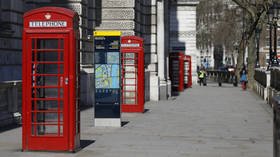Now Imperial College scientists behind flawed Covid-19 advice claim lockdown saved 3mn lives! It’s unscientific, self-serving BS

After scaring governments into ordering shutdowns that trashed our economies, the scientists are now hailing themselves as saviors. But even their own new paper reveals that countries which didn’t lock down fared just as well.
A new paper from the team of Imperial College modelers who scared the hell out of governments around the world, published yesterday by Nature, claims “major non-pharmaceutical interventions, and lockdown in particular, have had a large effect on reducing transmission” of Covid-19.
They claim these interventions saved over three million lives in 11 countries across Europe. But a little digging suggests that this paper grossly overstates its case and can’t be used to justify the lockdowns that most of these countries endured.
The headline numbers from the paper are that, as of May 4 (when restrictions started to be lifted in some larger countries), just under 129,000 deaths had been reported in these countries from Covid-19. However, if no action had been taken by governments, the modelers suggest, based on their original “do nothing” scenario, that 3.2 million deaths would have occurred. Scary stuff.
For individual countries, the number of lives apparently saved is even more impressive. By May 4, Italy had 29,079 deaths, but would have had 670,000 deaths were it not for lockdown. The UK would have had 500,000 deaths, but actually had 28,734. In Germany, 560,000 lives were saved; in Spain, it was 450,000.
In a briefing, Samir Bhatt, who co-led one of the studies by researchers at Imperial College London, told journalists: “The risk of a second wave happening if all interventions and all precautions are abandoned is very real.” He added that “any claims that this is all over, that we’ve reached the herd immunity threshold, can be firmly rejected. We are only at the beginning of this pandemic.” Not only were the lockdowns justified, but continued restrictions are essential.
However, a table at the end of the report suggests there may be a different story to tell. For example, many commentators have condemned Sweden for imposing only light restrictions, leaving bars and restaurants open and continuing schooling for everyone up to the age of 16.
Sweden had suffered 2,769 deaths by May 4, but the models predicted 28,000 deaths in Imperial’s “no-intervention” scenario. So, more than 90 percent of deaths were avoided without a lockdown – which is pretty much on par with certain other countries who locked down and trashed their economies.
Given the costs of the lockdown in the UK – how so many families have had to bear being apart from their loved ones for so long and how many jobs will be lost – that’s infuriating.
Also on rt.com Boris Johnson promised strong leadership over Covid-19 but delivered an omnishamblesSwitzerland is an even more stark case. Again, there was no formal lockdown. It’s true that the measures taken there were more stringent than in Sweden. Gatherings of more than 1,000 people were banned as early as February 28. On March 16, schools and most shops were closed nationwide, and on March 20, all gatherings of more than five people in public spaces were banned, but a lot of economic activity continued, including construction. Without a full-blooded lockdown, Switzerland – if the new report is to be believed – avoided over 97 percent of the deaths predicted by the Imperial College models.
The measures in Switzerland were unwound fairly quickly, too. From April 27, hairdressers, dentists, day-care workers and more could return to work with safety measures in place, along with DIY stores and garden centers. Schools and universities reopened on May 11.
So what’s the real lesson here, besides the fact that nothing from the flawed Imperial College modelers should be treated with anything but disdain?
Perhaps it is simply that what worked best was when significant restrictions on social interaction were imposed early. In the countries where there was a long delay between the first reported death and the imposition of social-distancing measures (short of lockdown), the death toll has been higher.
From the date of first death, the UK took 11 days to announce significant social-distancing measures, but schools weren’t closed until four days later and pubs five days later. The imposition of such restrictions took 15 days in Italy, 28 days in Spain and 29 days in France.
Sweden took five days, Germany four days and Norway imposed restrictions on the day the first death was announced. It’s not a perfect indicator, however. Belgium has also suffered terribly, but imposed restrictions the day after the first death was announced, suggesting the disease had already become well-established.
The UK government initially had a very different strategy, because it was being “guided by the science.” As late as March 13, Professor John Edmunds of the London School of Hygiene and Tropical Medicine was still appearing on television arguing the line of the UK government’s scientific advisers that few restrictions were needed and the aim should be to achieve “herd immunity” (although he eventually became a belated convert to lockdowns).
In other words, the best approach was for most young and middle-aged people to be infected. Younger people generally suffer mild disease if they have symptoms at all. Assuming they then have immunity, this would reduce the risk to more vulnerable people, who would just need to be locked down for a few weeks. (Full disclosure: I thought the experts made a fairly convincing case for this at the time.)
In short, having failed to impose any significant restrictions at all early on, many governments reacted late and imposed draconian lockdowns. In the UK, the result has been a particularly slow and over-cautious lifting of these restrictions.
Also on rt.com Should we get closer? Media report UK govt mulls scrapping two-meter social distancing rule amid infection-spread debateBut there is one big reason why the new Imperial College report should be treated with skepticism – it contains an astonishing caveat: “We do not account for changes in behavior; in reality, even in the absence of government interventions, we would expect [the reproduction rate] to decrease and therefore would overestimate deaths in the no-intervention model.” Straight from the scientist’s mouth...
We know that as word of the pandemic started to spread, people started to engage in social distancing for themselves. Public transport numbers fell sharply. In the UK, pubs and bars saw a huge drop in customers after the government asked people to avoid them, but days before they were forced to shut.
Professor Carl Heneghan of the Oxford-based Center for Evidence-Based Medicine has argued that infections probably peaked before the lockdown in the UK as the first social-distancing measures were announced. Sadly, they were given little chance to work before a full lockdown was imposed, such was the media and political pressure created by Imperial’s original intervention.
There was no doubt complacency among politicians about the seriousness of this disease. That was understandable, given the number of false alarms in the past. But that complacency was compounded by the advice from the “experts” – SAGE by name, but not sage in their advice. There were heated debates about whether closing schools was wise, for example (there still are).
This all has important implications for political decision-making. If we had known that 90 percent of deaths could have been avoided if we had followed a Swedish model – relatively light restrictions, but imposed quickly – would we have locked down? In fact, if Sweden had made a better job of protecting care homes, the death toll there would have been even lower.
We’ve trashed our economies and freedoms thanks to complacency, lack of preparation and poor scientific advice, followed by illiberal overreaction. The scary headline numbers from the Imperial College model’s “do-nothing” scenario bear no resemblance to any likely reality.
Banging the drum for continued restrictions is starting to look like self-justification. Maybe governments need to be a lot more skeptical about the advice of grandstanding experts, particularly these latter-day Imperialists.
Like this story? Share it with a friend!
The statements, views and opinions expressed in this column are solely those of the author and do not necessarily represent those of RT.














